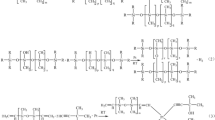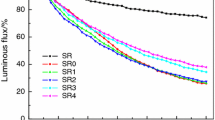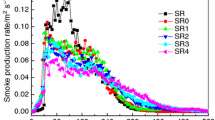Abstract
In order to improve the smoke suppression of silicone oil, relatively high nitrogen content silicone oil was synthesized by the reaction of dicyandiamide (DCD) and epoxy-terminated silicone oil (ETSO) and named DCDSO. The molecular structure of DCDSO was characterized by Fourier transform infrared spectroscopy (FT-IR) and nuclear magnetic resonance spectroscopy (NMR). The flame ignition and cone calorimetry test (CCT) were used to investigate the smoke suppression effect of DCDSO. The results showed that the introduction of DCD significantly improved the smoke suppression performance of DCDSO. When the molar ratio of the epoxy group in ETSO and the primary amino group in DCD was 1:1.3, the flame height and the total smoke production were significantly reduced. Thermogravimetric analysis (TGA), thermogravimetric infrared analysis (TG-IR) and thermal field emission scanning electron microscopy (SEM) were used to explore the mechanism of smoke suppression. The mechanism of smoke suppression is that the introduction of DCD reduces the rearrangement decomposition, promotes the free radical oxidation decomposition and the formation of condensed phase, and thus reduces the generation and release of smoke.
Similar content being viewed by others
Data availability
The datasets generated during and/or analysed during the current study are available from the corresponding author on reasonable request.
References
Chen DJ, Zhu AL, Li LJ, Pei YC (2015) Anti-splash agent used for spray welding process, comprises specified amount of petroleum resin, chlorinated polyethylene resin, fumed silica, dearomatized solvent oil and cyclohexanol. China CN201510164570.9
Zhu C, Deng C, Cao JY, Wang YZ (2015) An efficient flame retardant for silicone rubber: Preparation and application. Polym Degrad Stab 121:42–50
Zhang Y, He JY, Yang RJ (2016) The effects of phosphorus-based flame retardants and octaphenyl polyhedral oligomeric silsesquioxane on the ablative and flame-retardation properties of room temperature vulcanized silicone rubber insulating composites. Polym Degrad Stab 125:140–147
Zhou C, Wang J, Li JX, Shi J (2020) Thermal aging properties of flame retardant silicone rubber based on melamine cyanurate. J Appl Polym Sci 138(9):49919
Fang YZ, Miao JS, Yang XW, Zhu Y, Wang GY (2019) Fabrication of polyphosphazene covalent triazine polymer with excellent flame retardancy and smoke suppression for epoxy resin. Chem Eng J 385:123830
Yang JC, Ma WS, Hu DC, Zhang DQ, Wu L, Yang B, Zhang SH (2020) Facile preparation and flame retardancy mechanism of cyclophosphazene derivatives for highly flame-retardant silicone rubber composites. Journal of Applied Polymer Science 50297
Sag J, Kukla P, Goedderz D, Roch H, Kabasci S, Döring M, Schönberger F (2020) Synthesis of novel polymeric acrylate-based flame retardants containing two phosphorus groups in different chemical environments and their influence on the flammability of poly (lactic acid). Polymers 12(4):778
Chen XL, Ma CY, Jiao CM (2016) Synergistic effects between iron-graphene and ammonium polyphosphate in flame-retardant thermoplastic polyurethane. J Therm Anal Calorim 126(2):633–642
Morgan AB, Wilkie CA (2014) Non-halogenated flame retardant handbook. 143–168
Horacek H, Grabner R (1996) Advantages of flame retardants based on nitrogen compounds. Polym Degrad Stab 54(2–3):205–215
Xu WZ, Wang GS, Xu JY, Liu YC, Chen R, Yan HY (2019) Modification of diatomite with melamine coated zeolitic imidazolate framework-8 as an effective flame retardant to enhance flame retardancy and smoke suppression of rigid polyurethane foam. J Hazard Mater 379(5):120819
Beduini A, Carosio F, Ferruti P, Ranucci E, Alongi J (2021) Polyamidoamines derived from natural α-amino acids as effective flame retardants for cotton. Polymers 13:3714
Jeng RJ, Wang JR, Lin JJ, Liu YL, Chiu YS, Su WC (2001) Flame retardant epoxy polymers using phosphorus-containing polyalkylene amines as curing agents. J Appl Polym Sci 82(14):3526–3538
Pan KX, Zeng XR, Li HQ, Lai XJ, Chen ZH, Liang GQ (2016) Synthesis of phenyl silicone resin with epoxy and acrylate group and its adhesion enhancement for addition-cure silicone encapsulant with high refractive index. J Adhes Sci Technol 30(24):2699–2709
Sahu M, Narashimhan L, Prakash O, Raichur AM (2017) Non-covalently functionalized tungsten disulfide nanosheets for enhanced mechanical and thermal properties of epoxy nanocomposites. ACS Appl Mater Interfaces 9(16):14347–14357
Rayée Q, Nguyen PT, Segato T, Delplancke-Ogletree M-P, Doneux T, Buess-Herman C (2018) Electrochemical synthesis of copper(I) dicyanamide thin films. J Electroanal Chem 819:331–337
Yuan XH, Luo K, Wu YJ, He JL, Zhao ZS, Yu DL (2018) Investigation on the stability of derivative melam from melamine pyrolysis under high pressure. Nanomaterials 8(3):172
Wang Z, Zhang X, Wang RG, Kang HL, Qiao B, Ma J, Zhang LQ, Wang H (2012) Synthesis and characterization of novel soybean-oil-based elastomers with favorable processability and tunable properties. Macromolecules 45(22):9010–9019
György C, Smith T, Growney DJ, Armes SP (2022) Synthesis and derivatization of epoxy-functional sterically-stabilized diblock copolymer spheres in non-polar media: does the spatial location of the epoxy groups matter?†. Polym Chem 13:3619–3630
Pan ZQ, Sun R, Zhu SL, Kang YZ, Huang BS, Zhu LQ (2018) The synthesis, characterization and properties of silicone adhesion promoters for addition-cure silicone rubber. J Adhes Sci Technol 32(14):1517–1530
Kamalipour J, Beheshty MH, Zohuriaan-Mehr MJ (2022) Novel phosphonated hardeners derived from diamino diphenyl sulfone for epoxy resins: Synthesis and one-pack flame-retardant formulation alongside dicyandiamide. Polym Degrad Stab 199:109917
Zhang XH, Liu F, Chen S, Qi GR (2007) Novel flame retardant thermosets from nitrogen-containing and phosphorus-containing epoxy resins cured with dicyandiamide. J Appl Polym Sci 106(4):2391–2397
Zhao WJ, Kumar Kundu C, Li ZW, Li XH, Zhang ZJ (2021) Flame retardant treatments for polypropylene: Strategies and recent advances. Compos A Appl Sci Manuf 145:106382
Chen YJ, Xu LF, Wu XD, Xu B (2019) The influence of nano ZnO coated by phosphazene/ triazine bi-group molecular on the flame retardant property and mechanical property of intumescent flame retardant poly (lactic acid) composites. Thermochim Acta 679:178336
Camino G, Lomakin SM, Lazzari M (2001) Polydimethylsiloxane thermal degradation Part 1. Kinetic aspects Polymer 42:2395–2402
Ai LH, Chen SS, Yang L, Liu P (2021) Synergistic flame retardant effect of organic boron flame retardant and aluminum hydroxide on polyethylene. Fibers and Polymers 22(2):354–365
Rodolfo A, Mei LHI (2010) Metallic oxides as fire retardants and smoke suppressants in flexible poly(vinyl chloride). J Appl Polym Sci 118:2613–2623
Xu LF, Lei CH, Xu RJ, Zhang XQ, Zhang F (2016) Hybridization of α-zirconium phosphate with hexachlorocyclotriphosphazene and its application in the flame retardant poly(vinyl alcohol) composites. Polym Degrad Stab 133:378–388
Bo CY, Shi ZY, Hu LH, Pan Z, Hu Y, Yang XH, Jia PY, Ren XL, Zhang M, Zhou YH (2020) Cardanol derived P, Si and N based precursors to develop flame retardant phenolic foam. Scientific Reports Scientific Reports 10(1):12082
Lee J-H, Shin H, Rhee KY (2019) Surface functionalization of boron nitride platelets via a catalytic oxidation/silanization process and thermomechanical properties of boron nitride- epoxy composites. Compos B Eng 157(15):276–282
Zhang YB, Yan HX, Feng GP, Liu R, Yang KM, Feng WX, Zhang SY, He C (2021) Non-aromatic Si, P, N-containing hyperbranched flame retardant on reducing fire hazards of epoxy resin with desirable mechanical properties and lower curing temperature. Compos B Eng 222(1–3):109043
Zhu XD, Mao QY, Zhong QF, Zhang ZH, Wang G, Tang L, Xiao J (2022) A novel low-temperature fluorination roasting mechanism investigation of regenerated spent anode graphite via TG-IR analysis and kinetic modeling. ACS Omega 7(13):11101–11113
Xu ZR, Xu ZH, Tao R, Mao LC, Zhan J, Xiao JF, Yu T (2022) Combustion and thermal properties of flame retardant polyurethane foam with ammonium polyphosphate synergized by phosphomolybdic acid. Front Mater 9:944368
Chen XL, Zhuo JL, Jiao CM (2012) Thermal degradation characteristics of flame retardant polylactide using TG-IR. Polym Degrad Stab 97(11):2143–2147
Zhu ZM, Xu YJ, Liao W, Xu SM, Wang YZ (2017) Highly flame retardant expanded polystyrene foams from phosphorus-nitrogen-silicon synergistic adhesives. Ind Eng Chem Res 56(16):4649–4658
Szolnoki B, Bocz K, Marosi G, Toldy A (2016) Flame retardancy of sorbitol based bioepoxy via combined solid and gas phase action. Polymers 8(9):322
Huang QY, Xue HJ, Dong RT, Xue Y, Zhou XD, Li ZC, Li Q (2022) Simple and green synthesis of calcium alginate/hydroxyapatite hybrid material without high temperature treatment and its flame retardancy. Cellulose 29(3):1759–1774
Acknowledgements
This work was supported by the Fuyang Science and Technology Department, China (FK20208021).
Funding
This work was supported by Fuyang Science and Technology Department (Grant numbers FK20208021).
Author information
Authors and Affiliations
Contributions
Xu Shi wrote the main manuscript text and prepared all figures. Weibing Xu, Zhengfa Zhou, Haihong Ma and Fengmei Ren reviewed the manuscript.
Corresponding author
Ethics declarations
Competing interests
The authors declare no competing interests.
Ethics approval
Not applicable.
Consent to participate
Yes. All permission granted.
Consent for publication
Yes. All permission granted.
Additional information
Publisher's Note
Springer Nature remains neutral with regard to jurisdictional claims in published maps and institutional affiliations.
Rights and permissions
Springer Nature or its licensor (e.g. a society or other partner) holds exclusive rights to this article under a publishing agreement with the author(s) or other rightsholder(s); author self-archiving of the accepted manuscript version of this article is solely governed by the terms of such publishing agreement and applicable law.
About this article
Cite this article
Shi, X., Xu, W., Zhou, Z. et al. Preparation and Properties of Smoke Suppressive Silicone Oil Modified by Dicyandiamide. Silicon 15, 4325–4334 (2023). https://doi.org/10.1007/s12633-023-02356-z
Received:
Accepted:
Published:
Issue Date:
DOI: https://doi.org/10.1007/s12633-023-02356-z




